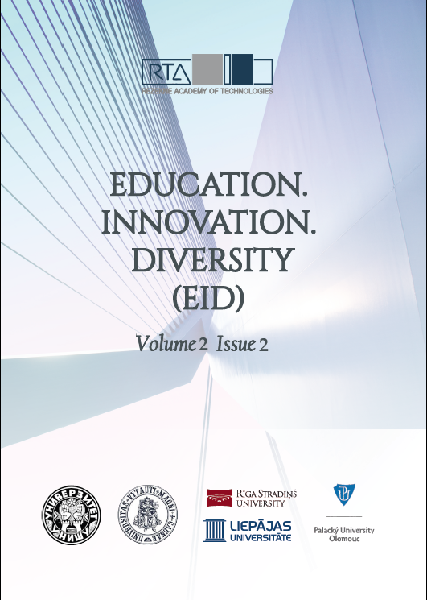MODERN APPROACHES OF STUDENT'S SOCIAL HEALTH FORMATION IN THE PROCESS OF PHYSICAL EDUCATION
DOI:
https://doi.org/10.17770/eid2021.1.5420Keywords:
education system, reformation, schoolchildren, school subject ‘Physical Education’, social healthAbstract
Objective: to ascertain the influence of the updated Physical Education syllabus in the context of forming social health of secondary school students, as well as motivation of schoolchildren for Physical Education classes. Material: 457 school students (230 females and 227 males) of the 6th and 7th grades (aged 12-13) from different regions of Ukraine were respondents of the survey.
Method: observation, interviews and the authors’ questionnaires (‘Interest in Physical Education’with the use of customized tests by M. Ginzburg (Zaniuk, 2002), questionnaires ‘value orientations’ by M. Rokeach (Rozov, 2005), ‘Orientation towards Increasing Social Health of a Person’, as well as a questionnaire on the need of accomplishments by Yu. Orlov and Reyzas Assertiveness Schedule (Big Encyclopedia of Psychological Tests, 2007).
Results: It was discovered that in 2008-2009 only 23.7% of schoolchildren liked physical education classes. Within this period of time, 18.5% of school students had a high level of orientation towards improving their own social health. The corrections made in 2012 to Physical Education syllabus contributed to an increase in the number of school students with a high level of motivation for Physical Education classes(+ 41.7%), as well as the number of students who had a high level of orientation towards improving their own social health (+23.3%). Positive changes were also recorded after the improvement of Physical Education syllabus in 2017 (under conditions of Physical Education reformation in Ukraine). The number of schoolchildren with a high level of motivation for Physical Education classes increased by 10.5% compared with the results recorded in 2012-2016. The number of students aimed at improving their own state of social health increased by 17.1%.
The content of Physical Education syllabus of years 2012 and 2017 has significant advantages over the syllabus of the Soviet times in the context of developing students’ desire to be engaged in Physical Education on the whole and improve their own level of social health in particular. It is characterized by the improvement of the system of assessing schoolchildren’s achievements in physical fitness, the option to increase the amount of time devoted to students’ mastering various kinds of sports that are of particular interest to them, and the focus on providing schoolchildren with key life competencies.
References
Big Encyclopedia of Psychological Tests (2007). Moscow: Eksmo.
Danilova, L. (2010). Physical Education of Schoolchildren in Canada, Germany and USA or How to Win Olympics, Volume 5, 2-7. Yaroslavl State Pedagogical University. Yaroslavl.
Iermakova, T. (2014). Development of the idea of forming health culture of a person in the world educational thought. Pedagogics, psychology, medical-biological problems of physical training and sports, Volume4, Issue 18, 8-12. DOI: https://doi.org/10.6084/m9.figshare.950949
Kenioua, М. & Boumasjed, А. (2016), Sport and mental health level among university students. Physical Education of Students, Volume 3, Issue 20, 39-42. DOI: https://doi.org/10.15561/20755279.2016.0305
Kondakov, V., Kopeikina, E., Balysheva, N., Usatov, A., & Skrug, D. (2015). Causes of declining interest of students to employment physical education and sports. Physical education of students, Volume1, Issue 19, 17-21. DOI: https://doi.org/10.15561/20755279.2015.0103
Liashenko, V., Tumanova, V., Gnutova, N., & Gnutov E. (2017). Special aspects of 12-14 yrs children’s psychological protection. Pedagogics, psychology, medical-biological problems of physical training and sports, Volume 4, Issue 21, 180-184. DOI: https://doi.org/10.15561/18189172.2017.0406
Osadchaya, T. (2004). The System for Monitoring Students’ Achievements in Physical Education in the US Schools. Physical Education of Students, Volume2, 68-78.
Physical Education Syllabus for Grades 5–9 of Secondary School (2017). Retrieved from: https://osvita.ua/school/program/program-5-9/56135
Physical Education Syllabus for Grades 5–9 of Secondary School (2012). Kyiv.
Radzimińska, A., Weber-Rajek, M., Lulińska-Kuklik, E., Kaźmierczak, U., & Moska, W. (2016). Academic youth’s health behavior. Physical education of students, Volume 6, Issue 20, 55-62. DOI: https://doi.org/10.15561/20755279.2016.0607
Rozov, V.I. (2005). Adaptive Anti-stress Psychotechnologies: Teach. Manual. Kyiv: Kondor.
Saparhasimova, A. & Pluzhnov, A.(2017). Physical Education and Sports in West European Countries. Scientific Research. Retrieved from: http://repo.kspi.kz/bitstream/handle/item
The Law of Ukraine ‘On Education’ (2017). Kyiv. Retrieved from: http://w1.c1.rada.gov.ua
The New Ukrainian School: the Basic Concepts of the Standard of Education (2016). Lviv. Retrieved from: http://nus.org.ua
Turchyk, I., Vaceba, O., & Biriuk, S. (2009). Physical Education Class in the System of Primary School Education of Poland. Young Sport Science of Ukraine, Volume 2, 187-191.
Uvarov, E., Belaid, M., & Yahiaoui, S. (2016). The Content of the Physical Education Programs in Schools of Europe and Russia. Bulletin of Tambov University. Series: Humanities. Retrieved from: https://cyberleninka.ru
Zaniuk, S. (2002). Psykholohiia motyvatsii. Navchalnyi posibnyk. K.: Lybid.






